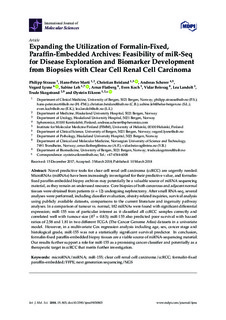| dc.contributor.author | Strauss, Philipp | |
| dc.contributor.author | Marti, Hans-Peter | |
| dc.contributor.author | Beisland, Christian | |
| dc.contributor.author | Scherer, Andreas | |
| dc.contributor.author | Lysne, Vegard | |
| dc.contributor.author | Leh, Sabine Maria | |
| dc.contributor.author | Flatberg, Arnar | |
| dc.contributor.author | Koch, Even Evjen | |
| dc.contributor.author | Beisvag, Vidar | |
| dc.contributor.author | Landolt, Lea Zoe | |
| dc.contributor.author | Skogstrand, Trude | |
| dc.contributor.author | Eikrem, Øystein Solberg | |
| dc.date.accessioned | 2019-02-18T08:49:22Z | |
| dc.date.available | 2019-02-18T08:49:22Z | |
| dc.date.created | 2018-06-10T14:34:00Z | |
| dc.date.issued | 2018 | |
| dc.identifier.citation | International Journal of Molecular Sciences. 2018, 19:803 (3), 1-18. | nb_NO |
| dc.identifier.issn | 1422-0067 | |
| dc.identifier.uri | http://hdl.handle.net/11250/2585820 | |
| dc.description.abstract | Novel predictive tools for clear cell renal cell carcinoma (ccRCC) are urgently needed. MicroRNAs (miRNAs) have been increasingly investigated for their predictive value, and formalin-fixed paraffin-embedded biopsy archives may potentially be a valuable source of miRNA sequencing material, as they remain an underused resource. Core biopsies of both cancerous and adjacent normal tissues were obtained from patients (n = 12) undergoing nephrectomy. After small RNA-seq, several analyses were performed, including classifier evaluation, obesity-related inquiries, survival analysis using publicly available datasets, comparisons to the current literature and ingenuity pathway analyses. In a comparison of tumour vs. normal, 182 miRNAs were found with significant differential expression; miR-155 was of particular interest as it classified all ccRCC samples correctly and correlated well with tumour size (R2 = 0.83); miR-155 also predicted poor survival with hazard ratios of 2.58 and 1.81 in two different TCGA (The Cancer Genome Atlas) datasets in a univariate model. However, in a multivariate Cox regression analysis including age, sex, cancer stage and histological grade, miR-155 was not a statistically significant survival predictor. In conclusion, formalin-fixed paraffin-embedded biopsy tissues are a viable source of miRNA-sequencing material. Our results further support a role for miR-155 as a promising cancer classifier and potentially as a therapeutic target in ccRCC that merits further investigation. | nb_NO |
| dc.language.iso | eng | nb_NO |
| dc.publisher | MDPI | nb_NO |
| dc.rights | Navngivelse 4.0 Internasjonal | * |
| dc.rights.uri | http://creativecommons.org/licenses/by/4.0/deed.no | * |
| dc.title | Expanding the utilization of formalin-fixed, paraffin-embedded archives: Feasibility of miR-Seq for disease exploration and biomarker development from biopsies with clear cell renal cell Carcinoma | nb_NO |
| dc.type | Journal article | nb_NO |
| dc.type | Peer reviewed | nb_NO |
| dc.description.version | publishedVersion | nb_NO |
| dc.source.pagenumber | 1-18 | nb_NO |
| dc.source.volume | 19:803 | nb_NO |
| dc.source.journal | International Journal of Molecular Sciences | nb_NO |
| dc.source.issue | 3 | nb_NO |
| dc.identifier.doi | 10.3390/ijms19030803 | |
| dc.identifier.cristin | 1590269 | |
| dc.description.localcode | © 2018 by the authors. Licensee MDPI, Basel, Switzerland. This article is an open access article distributed under the terms and conditions of the Creative Commons Attribution (CC BY) license (http://creativecommons.org/licenses/by/4.0/). | nb_NO |
| cristin.unitcode | 194,65,15,0 | |
| cristin.unitname | Institutt for klinisk og molekylær medisin | |
| cristin.ispublished | true | |
| cristin.fulltext | original | |
| cristin.qualitycode | 1 | |

